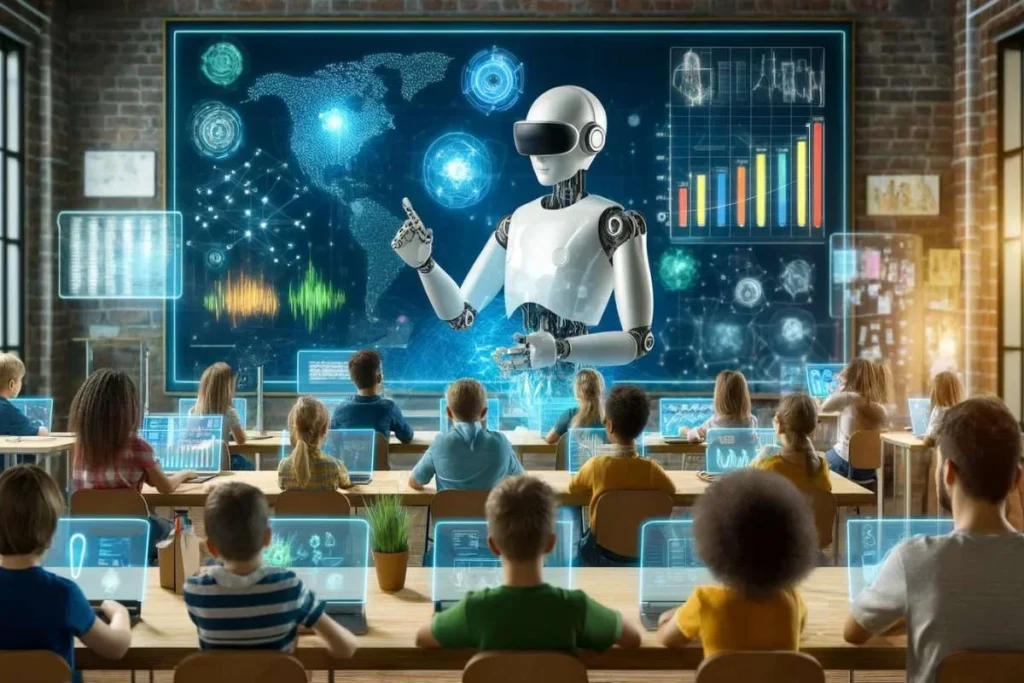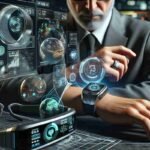Introduction: The Question of Human vs. Machine Learning
The rise of artificial intelligence (AI) has transformed countless industries, from healthcare to business management, but one of the most debated questions today is whether AI can truly replace traditional education. Schools and universities have stood as the backbone of knowledge-sharing for centuries, emphasizing social interaction, mentorship, and structured learning. At the same time, AI-driven platforms are offering personalized tutoring, adaptive testing, and data-driven insights that promise to revolutionize the way students learn. This clash between innovation and tradition sparks an important debate: are we moving toward a future where classrooms become obsolete, or will AI only complement teachers rather than replace them?
Education is not simply about transmitting information; it involves shaping personalities, instilling critical thinking, and preparing individuals to function within society. As AI tools become increasingly sophisticated, it is crucial to assess their advantages, limitations, and potential consequences. To fully answer whether AI can truly replace traditional education, we must look beyond technology’s efficiency and explore its impact on the human side of learning.
The Evolution of Traditional Education Systems
For centuries, education has relied on teachers, classrooms, and standardized curricula to deliver knowledge. From the one-room schoolhouses of the 19th century to today’s modern universities, the traditional system emphasizes structured lessons, face-to-face communication, and social engagement. One of its main strengths is the ability to nurture emotional intelligence, empathy, and real-world collaboration, which are harder to replicate in a digital format.
Even as digital tools, such as e-learning platforms and online courses, began supplementing education, traditional institutions remained dominant because they provide more than academic content. They shape community values, foster debate, and encourage creativity through human mentorship. However, with AI entering the classroom, we now see a new wave of disruption where intelligent systems are attempting to perform roles once exclusive to teachers.
How AI Is Entering the Classroom
AI is no longer just a futuristic concept; it is actively reshaping classrooms today. From adaptive learning platforms to AI-powered grading systems, schools and universities are increasingly adopting tools that reduce administrative burdens while enhancing personalization for students. For example, platforms like Carnegie Learning and Coursera integrate AI to adjust lesson difficulty based on student performance, while chatbots answer routine questions, freeing up teachers’ time for more meaningful interaction.
Key areas where AI is being applied:
- Personalized learning pathways that adapt to individual student needs.
- Automated grading and feedback systems to speed up evaluation.
- AI tutors and chatbots that provide instant assistance 24/7.
- Predictive analytics to identify struggling students early.
- Immersive learning environments using VR and AI simulations.
These innovations suggest AI has the potential to make education more efficient, equitable, and accessible. However, efficiency alone does not guarantee better education outcomes, especially when we consider the deeper emotional and developmental aspects of learning.
Comparing AI and Traditional Education Models
To better understand the impact, let’s examine the key differences between AI-driven education and traditional learning environments.
| Aspect | AI-Based Education | Traditional Education |
| Personalization | Adapts in real-time to student performance | One-size-fits-all, though teachers adjust individually |
| Accessibility | Available globally with internet access | Limited by geography and infrastructure |
| Human Interaction | Minimal, mostly machine-based | High, includes emotional and social support |
| Feedback Speed | Instant and data-driven | Slower, depends on teacher workload |
| Skill Development | Strong in technical knowledge | Strong in social, emotional, and critical thinking skills |
This comparison highlights that while AI excels at personalization and efficiency, traditional education continues to dominate in areas involving human relationships, ethics, and holistic development.
Strengths of AI in Education
One of AI’s most celebrated strengths is its ability to offer individualized learning experiences. Traditional classrooms often struggle with diverse student needs, but AI can instantly adjust difficulty levels, recommend resources, and ensure that no learner is left behind. This democratizes access to knowledge by breaking barriers of geography and financial status, enabling students worldwide to tap into high-quality educational resources.
Another significant strength lies in AI’s ability to process massive datasets. Through predictive analytics, educators can identify patterns that reveal which students are at risk of falling behind. By intervening earlier, institutions can reduce dropout rates and improve academic outcomes. Additionally, AI-powered grading reduces teacher workload, allowing educators to focus on more interactive and creative tasks rather than repetitive administrative duties.
Weaknesses and Limitations of AI in Education
Despite its strengths, AI in education has critical weaknesses. A major concern is the lack of emotional intelligence. Learning is not only about knowledge but also about socialization, teamwork, and empathy—all areas where AI struggles. Students require encouragement, mentorship, and motivation, which machines cannot provide with authenticity.
Another limitation is the issue of data bias and accessibility. AI systems are only as good as the data fed into them. Biased algorithms can unintentionally disadvantage certain groups of students, reinforcing inequality rather than solving it. Furthermore, not every region has access to the high-speed internet and digital devices required to leverage AI fully, leaving disadvantaged communities behind.
Lastly, the concern about over-dependence on technology cannot be ignored. If students rely solely on AI-driven tools, they may miss out on critical interpersonal skills needed in workplaces and society.
Can AI Replace Teachers Entirely?
The question of whether AI can replace teachers is at the core of this debate. While AI is excellent at delivering content, grading assignments, and personalizing learning, it cannot replicate the human connection, mentorship, and cultural context that teachers bring. Education is more than just the transfer of information; it is about building trust, instilling values, and fostering creativity—all of which require human judgment.
Teachers play a critical role in adapting lessons to real-world events, engaging students through discussions, and teaching empathy by example. While AI may serve as an advanced tool or teaching assistant, replacing educators entirely would risk dehumanizing the learning process and reducing education to mere content delivery.
Student Engagement and Human Interaction
Student engagement depends heavily on human interaction. In classrooms, students learn from group projects, debates, and peer collaboration, which build confidence and communication skills. AI-driven education often lacks these interpersonal experiences, leaving students isolated and detached.
Moreover, teachers provide not just academic knowledge but also emotional support during challenges, encouragement to overcome failures, and personalized mentorship. These elements are essential for shaping well-rounded individuals who can thrive in real-world settings. AI, with all its intelligence, cannot share personal anecdotes, empathize with student struggles, or inspire through lived experiences.
Case Studies: Blended Models in Action
Many educational institutions are already experimenting with blended learning models, where AI complements traditional teaching rather than replaces it. For example, the Georgia Institute of Technology introduced an AI teaching assistant named “Jill Watson” in online courses. Students often did not realize they were interacting with AI because responses were immediate and accurate. However, the presence of human professors ensured that deeper, value-driven discussions were still facilitated.
Similarly, schools in Finland and Singapore are integrating AI-based adaptive platforms alongside classroom teaching. These countries demonstrate that AI is most effective when used as a supportive tool rather than a full replacement, creating an environment that benefits from the best of both worlds.
Ethical and Privacy Concerns in AI Education
Another critical issue is the ethical implications of AI in education. Data privacy remains a top concern as AI platforms collect vast amounts of student information, including performance records, behavior analytics, and personal details. Without proper regulations, this sensitive data could be misused or exploited.
Additionally, relying too heavily on AI risks reinforcing algorithmic biases. For instance, if AI systems are trained primarily on Western educational content, students from other regions may face cultural mismatches or irrelevant examples. Therefore, policymakers and educators must establish guidelines to ensure ethical, inclusive, and fair use of AI in classrooms.
The Future of AI in Education: Replacement or Partnership?
Looking ahead, it seems unlikely that AI will fully replace traditional education. Instead, the future points toward a partnership model, where AI enhances human teaching rather than eliminates it. Just as calculators did not replace mathematicians but empowered them, AI will likely serve as an advanced assistant, making learning more efficient and accessible.
The ultimate goal should be to harness AI for what it does best—handling repetitive tasks, personalizing content, and providing data insights—while preserving the human essence of education that fosters creativity, empathy, and critical thinking. This balance will determine whether AI becomes a revolutionary tool or a disruptive force in the years ahead.
Practical Tips for Balancing AI and Traditional Education
To create an effective educational system, institutions must integrate AI thoughtfully without undermining traditional values. Here are some practical approaches:
- Adopt blended learning where AI handles personalization and teachers focus on mentorship.
- Prioritize student privacy by using transparent and ethical AI systems.
- Invest in teacher training to ensure educators know how to use AI tools effectively.
- Maintain social learning activities such as group discussions and collaborative projects.
- Evaluate AI platforms regularly to prevent algorithmic bias and inequality.
By implementing these strategies, schools and universities can strike a balance between innovation and tradition, ensuring that education remains both effective and human-centered.
Future Education Scenarios with AI
| Scenario | Description | Impact on Students | Role of Teachers |
| Full AI Replacement | AI completely replaces human teaching | Loss of human connection, efficiency gains | Minimal role |
| Blended Learning | AI complements traditional classrooms | Best of both worlds; personalization + socialization | Strong role as mentors |
| Minimal AI Use | Traditional methods dominate, AI only used for admin | Maintains human values but lacks tech efficiency | Central role |
This table highlights that the most promising path lies in blended learning models, where AI and teachers work hand in hand.
Conclusion: A Human-Centered Future for Education
So, can AI really replace traditional education? The answer is complex. While AI offers remarkable tools for personalization, efficiency, and accessibility, it cannot replicate the human relationships, mentorship, and emotional depth that traditional education provides. Instead of replacement, the future lies in collaboration between AI and educators, creating a system where students receive the best of both technology and human interaction.
Ultimately, education is not only about transmitting knowledge but also about shaping values, building communities, and preparing individuals to thrive in society. AI can enhance this mission, but it cannot replace the heart of learning: human connection.
FAQs on AI and Traditional Education
1. Can AI completely replace teachers in schools?
No. AI can support teaching by handling repetitive tasks, but it cannot replicate the emotional and social aspects of human mentorship.
2. How does AI improve student learning?
AI offers personalized learning pathways, instant feedback, and adaptive resources tailored to individual student needs.
3. What are the risks of AI in education?
Risks include data privacy concerns, algorithmic bias, reduced social interaction, and overdependence on technology.
4. Which countries are leading in AI-based education?
Countries like Singapore, Finland, and the United States are pioneering blended learning models that integrate AI.
5. Is AI education more affordable than traditional schooling?
AI platforms often reduce costs by offering scalable digital solutions, but they still require internet and device access, which can be a barrier.
6. How do students benefit from blended learning models?
Blended models combine the personalization of AI with the mentorship and social engagement of traditional education.
7. Can AI help students with learning disabilities?
Yes, AI tools can adapt to individual learning challenges, providing customized support for students with disabilities.
8. What role will teachers have in the future with AI?
Teachers will act more as mentors, facilitators, and emotional guides while AI handles repetitive and data-driven tasks.
9. How can schools ensure ethical AI use?
By setting regulations, prioritizing privacy, using diverse datasets, and regularly evaluating AI systems.
10. Will AI reduce the need for schools and universities?
Not entirely. Physical institutions provide socialization, networking, and community-building opportunities that AI cannot replace.


